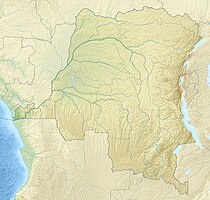Kamoto
| Kamoto | |||
|---|---|---|---|
| General information about the mine | |||
| Fan-shaped, slat-like lemon yellow kamotoite (Y) next to microcrystalline yellow uranophane and blue astrocyanite (Ce) from the Kamoto East mine | |||
| Mining technology | Opencast mining, underground mining | ||
| Information about the mining company | |||
| Operating company | UMHK (Union Minière du Haut-Katanga), Gécamines | ||
| Start of operation | 1953 | ||
| End of operation | still in operation (as of July 2014) | ||
| Successor use | Katanga Mining Limited | ||
| Funded raw materials | |||
| Degradation of | Copper-cobalt-uranium deposit | ||
| Geographical location | |||
| Coordinates | 10 ° 45 '2.1 " S , 25 ° 22' 59.2" E | ||
|
|||
| Location | Kamoto | ||
| province | Lualaba | ||
| Country | Democratic Republic of Congo | ||
Kamoto is a place about ten kilometers southwest of the city of Kolwezi in the copper belt of the Katanga province in the Democratic Republic of the Congo . Kamoto is known primarily as a mining area , represented by its five open-cast or underground mines "Kamoto Principal", "Kamoto North", "Kamoto East", "KOV" (Kamoto Oliveira Virgule) and "Mupine", which have been operating since the 1950s were operated and are now partially closed.
Mainly mined raw materials were and copper - cobalt - and uranium - ore .
geology
The main characteristic of the mineralization in Katanga is a wealth of dolomitic rock and intensive tectonic mixing. The strong tectonics with overturned folds, columns, fractures and displacements caused a remobilization of already settled minerals by circulating water, which results in the high degree of secondary mineralization . The minerals from Katanga Province, especially from Kamoto, are often rich in rare earths . The distribution of the proportions changes geologically from east to west. In Shinkolobwe , the heavier elements ( gadolinium , terbium ) are found, whereas minerals from Kamoto East tend to contain neodymium and cerium . It is assumed that the rare earths present in the secondary minerals originate from primary uraninite , which contained these as trace elements.
Kamoto Principal
Kamoto Principal was mined as an opencast mine, especially with regard to the minerals malachite , cuprite and cobalt calcite . Until October 1990, Kamoto Principal was also operated as an underground mine, here under the local name Kamoto Fond . From Kamoto Fond, centimeter-sized, high-gloss Carrollite crystals in paragenesis with sharp bornite are known. Planchite (katangite) and malachite often crystallized in cavities made of solid cuprite . In addition, chalcosine crystallized in Kamoto Fond in aggregates over ten centimeters in size.
Kamoto North
Kamoto North opened as the first expansion of the Kamoto Principal open pit mine. Here, uranium enrichments, especially uranophane , were found in crystals up to two centimeters in size. Furthermore, up to one centimeter large bornite crystals were found on calcite .
Kamoto East
Kamoto East represents the second expansion of the Kamoto Principal opencast mine. It was operated until the 1980s until it was exhausted. Mineralogically, uranium enrichment was discovered there in 1982 in an otherwise deaf zone, which at that time produced four new uranium rare earth minerals:
- Astrocyanite- (Ce) Cu 2 (Ce, Nd, La) 2 (UO 2 ) (CO 3 ) 5 (OH) 2 1.5 (H 2 O)
- Françoisite- (Nd) (Nd, Y, Sm, Ce) (UO 2 ) 3 | (O) (OH) | (PO 4 ) 2 · 6H 2 O
- Kamotoite- (Y) Y 2 (UO 2 ) 4 (CO 3 ) 3 (OH) 8 · 10–12 (H 2 O)
- Shabait- (Nd) Ca (Nd, Y) 2 (UO 2 ) (CO 3 ) 4 (OH) 2 6 (H 2 O)
Kamoto Ost is therefore considered the type locality for these minerals. For astrocyanite (Ce) and Shabaite (Nd), Kamoto Ost is also the only known site in the world to date (as of July 2014).
KOV
KOV (Kamoto Oliveira (name of a clod in the mining area, named after a prospector) Virgule (name of the main deposit)) was opened as an open pit mine in 1982. It connects the mining of Kamoto with those of Musonoi . In 1987, KOV delivered roubaultite crystals up to seven millimeters in size. KOV is still in operation today.
Mupine
Mupine is of only minor economic and mineralogical importance. It was mined between 1953 and 1982. The mineralogy corresponds to that of Musonoi. Spärocobaltite and cobalt calcite were found here.
today
Today Katanga Mining Limited mines copper and cobalt in Kamoto.
More mineral finds
A total of 40 recognized minerals have been discovered in the Kamoto mines, particularly copper, cobalt and uranium minerals. Among the copper and cobalt minerals, in addition to the already mentioned carrollite, these include kolwezite and libethenite . Uranium minerals could Uranophan addition, you still Becquerelit , Billietit , Cuprosklodowskit , Curit , Francevillit , Masuyit , Metastudtit , Sklodowskit , Soddyit , Vandenbrandeit and Zeunerit be found.
Web links
literature
- Josef Lhoest, Eddy van der Meersche: Lapis . Volume 17, No. 3 edition. Christian Weise Verlag GmbH, 1992, ISSN 0176-1285 , p. 29–40 (special issue: Shaba).


